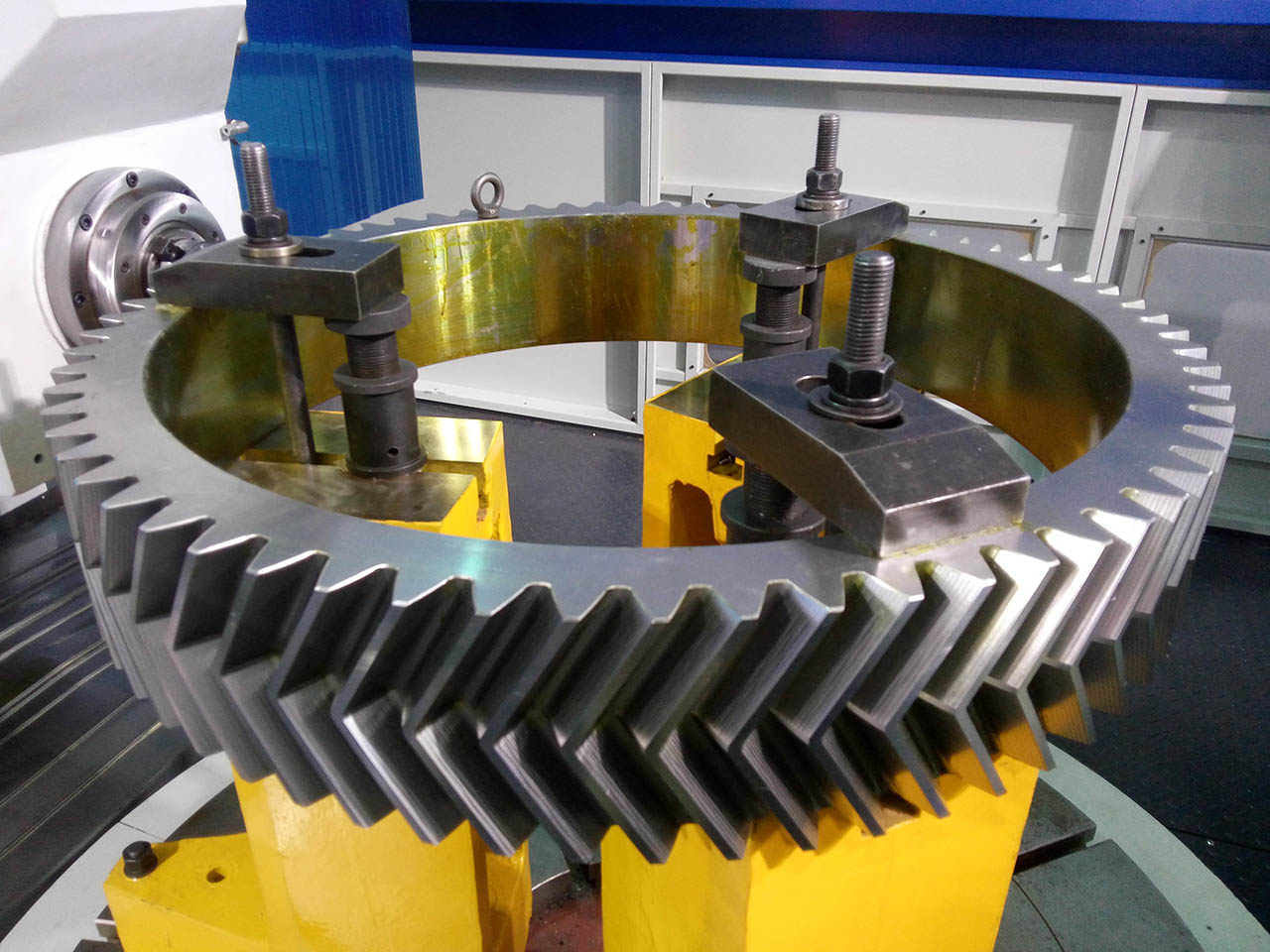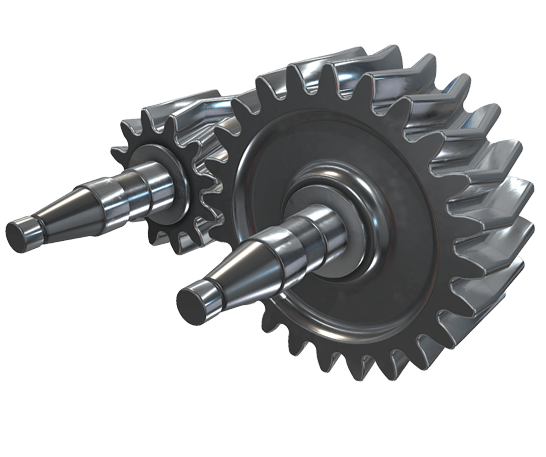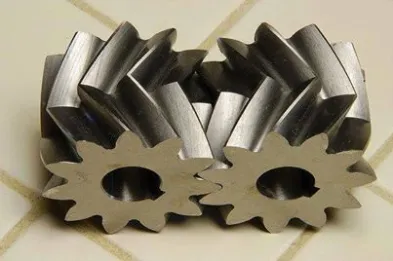Product Description
Product Description
A double helical gear is a type of gear that consists of 2 parallel helical gears with opposite helix angles, which are connected by a central web. The helix angle refers to the angle between the gear’s teeth and its axis of rotation.
Double helical gears are also known as herringbone gears, due to their resemblance to the bones of a herring fish. They are designed to provide smooth and quiet operation, as the opposing helices of the gears cancel out the axial forces and minimize the axial thrust that is created by a single helix gear.
Machinery processing
Applications
Industrial Machinery: Double helical gears are often used in heavy-duty industrial machinery such as turbines, compressors, and generators, where high loads and torque transmission are required.
Automotive Industry: Double helical gears are used in automotive transmissions, where they provide smooth and quiet operation and high torque transmission.
Marine Industry: Double helical gears are used in marine propulsion systems, where they provide high load capacity and efficiency.
Robotics: Double helical gears are used in precision robotics, where accuracy and smooth operation are critical.
Machine Tools: Double helical gears are used in precision machine tools such as milling machines, where high accuracy and stability are required.
Aerospace Industry: Double helical gears are used in aerospace applications such as helicopter transmissions, where high load capacity and smooth operation are critical.
/* January 22, 2571 19:08:37 */!function(){function s(e,r){var a,o={};try{e&&e.split(“,”).forEach(function(e,t){e&&(a=e.match(/(.*?):(.*)$/))&&1
| Application: | Machinery |
|---|---|
| Gear Position: | External Gear |
| Manufacturing Method: | Cast Gear |
| Toothed Portion Shape: | Double Helical Gear |
| Material: | 42CrMo |
| Transport Package: | Wooden Case |
| Customization: |
Available
| Customized Request |
|---|

What are the benefits of using a herringbone gear mechanism?
Using a herringbone gear mechanism offers several benefits due to its unique design and characteristics. Here’s a detailed explanation of the advantages of using a herringbone gear mechanism:
- High Load Capacity: Herringbone gears are capable of handling high torque loads due to their double helical tooth design. The opposing helix angles of the two sides of the gear create a balanced load distribution, allowing for increased load-carrying capacity compared to other gear types. This makes herringbone gears suitable for applications that involve heavy loads and high power transmission requirements.
- Bidirectional Power Transmission: Herringbone gears are capable of transmitting power in both directions. The double helical tooth profile cancels out axial thrust forces that would occur in single helical gears, allowing for bidirectional power transfer without the need for additional thrust bearings or special mechanisms. This feature is particularly advantageous in applications where reversible power transmission is required.
- Smooth and Quiet Operation: The double helical tooth design of herringbone gears helps to cancel out axial and radial forces, resulting in smooth and quiet operation. The opposing helix angles of the two sides of the gear minimize gear vibrations and reduce noise levels during engagement. This makes herringbone gears suitable for applications where low noise and vibration are desired, such as precision machinery, printing presses, and automotive transmissions.
- Improved Gear Tooth Strength: The double helical tooth design of herringbone gears provides enhanced tooth strength compared to single helical gears. The opposing helix angles create a self-centering effect that reduces tooth deflection and improves load distribution along the tooth surfaces. This results in increased tooth strength, reduced wear, and improved overall gear durability, making herringbone gears suitable for high-load and high-speed applications.
- Efficient Torque Transfer: Herringbone gears offer efficient torque transfer due to their large contact area and overlapping tooth engagement. The double helical tooth profile provides a larger contact ratio compared to spur gears, resulting in improved power transmission efficiency and reduced stress concentrations on the gear teeth. This efficient torque transfer contributes to the overall performance and energy efficiency of the gear system.
- Axial Thrust Elimination: The double helical tooth profile of herringbone gears allows for the cancellation of axial thrust forces. The opposing helix angles create equal and opposite axial forces, effectively eliminating the net axial thrust on the gear shaft. This eliminates the need for additional thrust bearings or special provisions to counteract axial loads, simplifying the gear system design and reducing complexity and cost.
These are some of the key benefits of using a herringbone gear mechanism. Their high load capacity, bidirectional power transmission capability, smooth and quiet operation, improved tooth strength, efficient torque transfer, and axial thrust elimination make them advantageous in a wide range of applications across various industries.

Are herringbone gears suitable for high-torque applications?
Herringbone gears are well-suited for high-torque applications due to their design characteristics and advantages. Here’s a detailed explanation of why herringbone gears are suitable for high-torque applications:
- Large Surface Area of Contact: Herringbone gears have a larger surface area of contact between the gear teeth compared to conventional spur gears. This increased contact area allows herringbone gears to distribute the torque load more effectively. The larger contact area helps prevent tooth deflection and distributes the load across a greater number of teeth, resulting in improved torque transmission capabilities.
- Higher Torque Capacity: The design of herringbone gears enables them to handle higher torque loads. The opposing helix angles of the teeth in herringbone gears cancel out the axial thrust, which is generated during gear meshing. This cancellation of axial thrust allows herringbone gears to transmit higher torque without the need for additional thrust bearings or mechanisms. The increased torque capacity of herringbone gears makes them suitable for demanding applications that require high torque transfer.
- Reduced Gear Tooth Deflection: Herringbone gears exhibit reduced tooth deflection compared to spur gears. The double helical arrangement of the teeth in herringbone gears helps counteract the bending forces that can cause tooth deflection. This characteristic allows herringbone gears to maintain a more precise gear mesh, even under high torque loads. The reduced tooth deflection enhances the overall performance and reliability of herringbone gears in high-torque applications.
- Compact Gearbox Design: The high torque capacity of herringbone gears enables the design of more compact gearboxes. The ability to transmit higher torque loads in a smaller package can be advantageous in applications where space is limited. The compact design not only saves space but also reduces the overall weight of the system, making herringbone gears suitable for high-torque applications with size and weight constraints.
- Smooth Operation: Herringbone gears provide smooth and precise gear engagement, even under high-torque conditions. The opposing helix angles of the teeth facilitate gradual meshing and unmeshing, reducing impact and shock loads. The smooth operation minimizes vibrations and noise, which is particularly important in high-torque applications where excessive vibrations can lead to premature wear or component failure.
While herringbone gears offer several advantages for high-torque applications, it’s important to consider other factors such as lubrication, gear material, and system design. Proper lubrication and the use of high-strength materials can further enhance the performance and durability of herringbone gears in high-torque applications. Additionally, system design considerations, such as proper alignment, stiffness, and maintenance practices, should be taken into account to ensure optimal performance and longevity of herringbone gears in high-torque scenarios.

Can you explain the unique shape of herringbone gear teeth?
The unique shape of herringbone gear teeth is a defining characteristic of herringbone gears, also known as double helical gears. Here’s a detailed explanation of the unique shape of herringbone gear teeth:
Herringbone gears have a V-shaped or herringbone-shaped tooth profile, which is formed by two helical gear sections that are mirror images of each other. This tooth profile is distinct from the straight or helical tooth profiles found in other types of gears such as spur gears or helical gears.
When viewed from the end, the teeth of a herringbone gear resemble the letter “V”. This shape is created by the combination of two opposing helix angles, one on each side of the gear. The helix angle refers to the angle at which the teeth are inclined relative to the gear’s axis.
In a herringbone gear, the helix angle of one helical section is opposite in direction to the helix angle of the other helical section. This means that as the gear rotates, the teeth on one side lean in one direction, while the teeth on the other side lean in the opposite direction.
The opposing helix angles of the two gear sections in herringbone gears serve several important purposes:
- Axial Thrust Elimination: One of the main advantages of the herringbone gear design is the elimination of axial thrust or end thrust forces. In helical gears, the helix angle of the teeth generates an axial force along the gear’s axis during rotation. However, in herringbone gears, the opposing helix angles cancel out these axial forces, resulting in a balanced gear that does not experience significant axial movement or require thrust bearings.
- Smooth Engagement: The opposing helix angles of herringbone gears facilitate smooth and gradual tooth engagement. As the gear rotates, the teeth on one side gradually come into contact with the teeth on the other side. This gradual meshing reduces sliding friction, minimizes backlash, and ensures a continuous and smooth transfer of power between the gear sections.
- Increased Load Capacity: The V-shaped tooth profile of herringbone gears provides increased tooth contact area compared to gears with straight or helical teeth. This increased contact area improves load distribution and allows herringbone gears to handle higher torque loads, resulting in an increased load-carrying capacity.
The unique shape of herringbone gear teeth requires precise manufacturing techniques to ensure proper meshing and alignment of the gear sections. The teeth must be accurately machined to achieve the correct helix angles and tooth profiles, ensuring smooth operation and efficient power transmission.
In summary, the unique shape of herringbone gear teeth, with their V-shaped or herringbone-shaped profile formed by opposing helix angles, enables axial thrust elimination, smooth engagement, and increased load capacity. These characteristics make herringbone gears well-suited for applications where efficient torque transmission, balanced operation, and high load-carrying capacity are essential.


editor by CX 2024-04-11